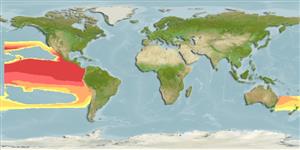Environment: milieu / climate zone / rango de profundidad / distribution range
Ecología
marino pelagic-oceanic; oceanodromo (Ref. 51243); rango de profundidad 0 - ? m. Subtropical
Eastern Pacific: southern California, USA to Panama, including the Galapagos Islands; rare in northern Baja California, Mexico. Range extends to Ecuador (Ref. 36576).
Tamaño / Peso / Age
Madurez: Lm ? range ? - ? cm
Max length : 48.0 cm TL macho / no sexado; (Ref. 2850); common length : 35.0 cm TL macho / no sexado; (Ref. 9306); peso máximo publicado: 223.25 g (Ref. 124487)
Short description
Claves de identificación | Morfología | Morfometría
Espinas dorsales (total) : 0; Radios blandos dorsales (total) : 12 - 15; Espinas anales: 0; Radios blandos anales: 11 - 13; Vértebra: 54 - 58. Body elongate; lower jaw very prolonged; upper jaw short, triangular, and without scales; lower branch of first gill arch with 26 to 32 gill rakers; fins lacking spines; pectoral fins long; caudal fin deeply forked, the lower lobe longer than the upper; anal fin with 10 to 13 rays; back dark blue; flanks and belly silvery white; edge of lower jaw red; upper lobe of caudal fin violet blue, its tip red (Ref. 55763). Branchiostegal rays: 13-15 (Ref. 36576).
Body shape (shape guide): elongated.
An oceanic species which occurs near surface. Adults form very big schools (Ref. 9306). Feed on small fishes and planktonic organisms (Ref. 9306). Oviparous, with planktonic larvae (Ref. 36576). Eggs are attached to floating objects via filaments (Ref. 36576). Found in markets of Panama (Ref. 9306).
Life cycle and mating behavior
Madurez | Reproducción | Puesta | Huevos | Fecundidad | Larva
Eschmeyer, W.N., E.S. Herald and H. Hammann, 1983. A field guide to Pacific coast fishes of North America. Boston (MA, USA): Houghton Mifflin Company. xii+336 p. (Ref. 2850)
IUCN Red List Status (Ref. 130435: Version 2025-1)
Threat to humans
Harmless
Human uses
Pesquerías: comercial; carnada: occasionally
Herramientas
Special reports
Download XML
Fuentes de Internet
Estimates based on models
Preferred temperature (Referencia
123201): 15.2 - 26.4, mean 19.7 °C (based on 68 cells).
Phylogenetic diversity index (Referencia
82804): PD
50 = 0.5005 [Uniqueness, from 0.5 = low to 2.0 = high].
Bayesian length-weight: a=0.00398 (0.00219 - 0.00722), b=2.97 (2.81 - 3.13), in cm total length, based on LWR estimates for this species & Genus-body shape (Ref.
93245).
Nivel trófico (Referencia
69278): 4.0 ±0.65 se; based on food items.
Resiliencia (Referencia
120179): Alto, población duplicada en un tiempo mínimo inferior a 15 meses (Preliminary K or Fecundity.).
Fishing Vulnerability (Ref.
59153): Moderate vulnerability (38 of 100).
🛈
